Along the inshore coasts of the Scottish mainland and isles, seasonal local subsistence herring fishing took place since Neolithic times [1-3]. From at least the medieval period, herring was mainly fished within the sheltered waters of the Firth of the Forth (Scottish east coast) and Firth of Clyde (Scottish west coast). Herring were caught during the summer season, when they were fattiest, using small open boats. Some fish were consumed fresh, but most were salted for out of season use and export [1]. The main competitors in herring fisheries were the Dutch. From the 15th century onwards, the Dutch merchants and “busses”, i.e., fully decked boats suitable for making trips of up to two months at a time, dominated the industry. Scottish fishermen over centuries attempted to develop a fishery with bigger boats and began to use similar techniques as the Dutch, such as drift nets and barrels for curing [1, 4]. Due to the proximity of their fishing grounds to the mainland and isles, the Scots had an advantage over the Dutch (who had to cure herring at sea), since on land curing could be conducted on a much larger scale. Consequently, onshore curing became a key element for the success of the Scottish herring fishery [1]. The implementation of bounties in 1785, money paid by the government based on the tonnage of barrels produced, further encouraged local herring fishing. It allowed curers to contract fishermen offering them fixed prices for their catch.
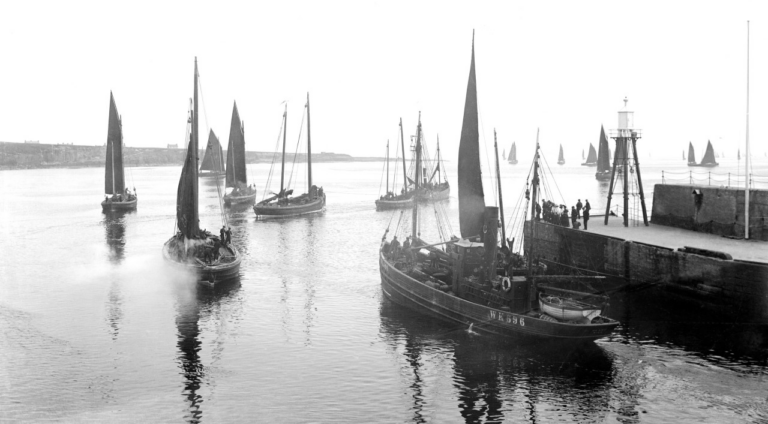
Following the implementation of a Fishery Board by the British government in 1809, cured herring were regularly inspected by fishery officers and received a “crown brand” for displaying quality control [1]. The Fishery Board was also keen to improve curing practices, and as a result, in the late 19th century, Scottish cured herring dominated the markets in Europe, ahead of the Dutch and Norwegian rivals [1]. The development of railways enabled fishermen and curers to deliver herring to markets at a faster rate. In 1840, production had increased from 100,000 exported barrels of cured herring in 1820, to over one million.
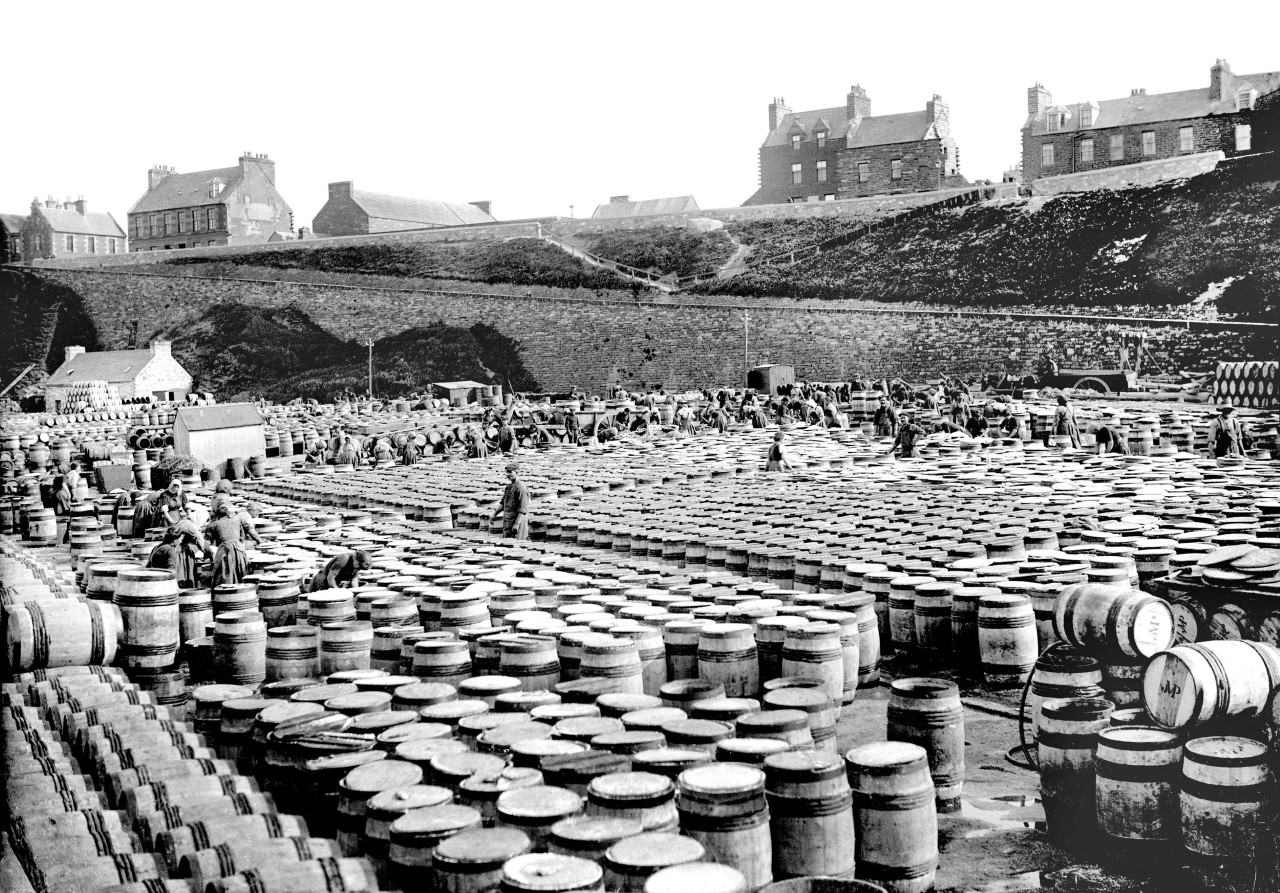
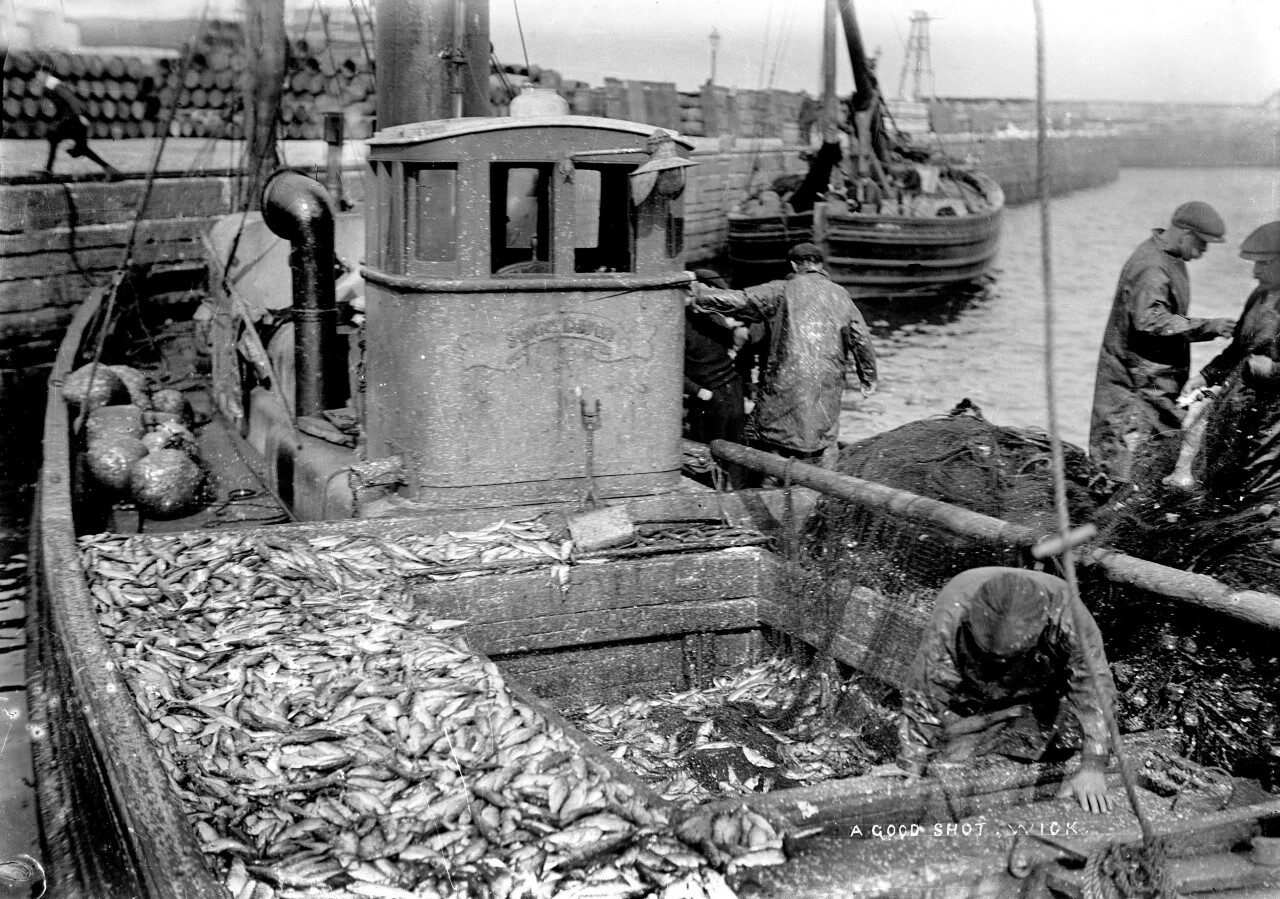
By the 1900s, the Scottish herring industry was producing over 2 million barrels of herring a year [5]. At that time, the industry employed over 35,000 people, of which, 14,000 were women [1, 6]. Along with the evolution of fishing methods, increasing consumer demand meant that men were called further offshore to follow herring shoals. As a result, on land, women were increasingly relied upon for processing and preserving the catch [7], given that herring, unless cured, would rot within a day. Women were employed to gut and pack the fish into barrels of salt, and their work was highly regarded. Hundreds of Scottish women would leave their homes to travel down the UK coast, in tandem with boats following shoals, entering employment as “herring lassies”. The women also cooked, cleaned, mended nets, and sometimes cleaned boats. Thus, the herring fishing industry had a significant positive impact on the livelihoods of Scottish women from fishing communities. They gained – for the first time – financial independence, freedom to travel, and visibility in a culture of female domesticity [8, 9].
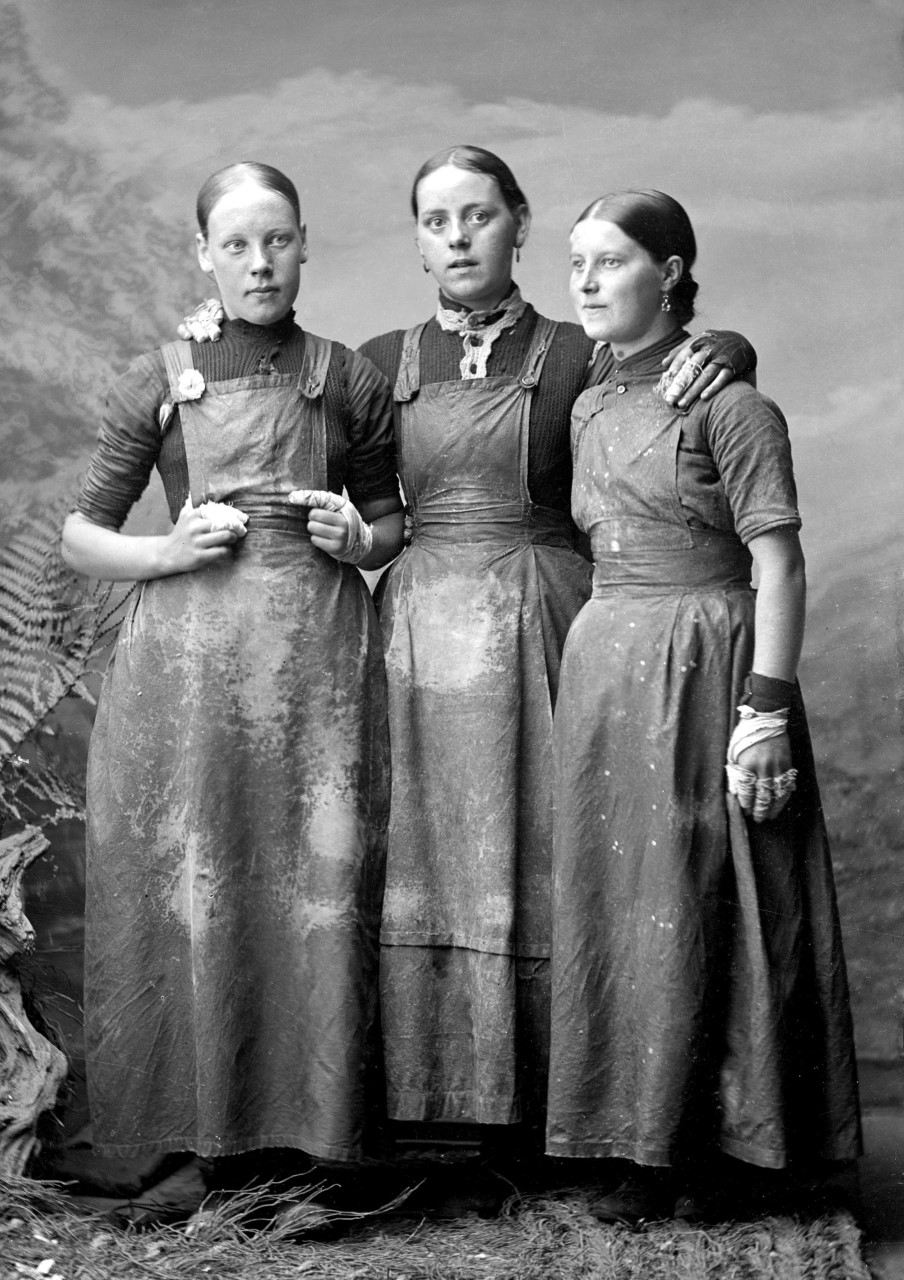
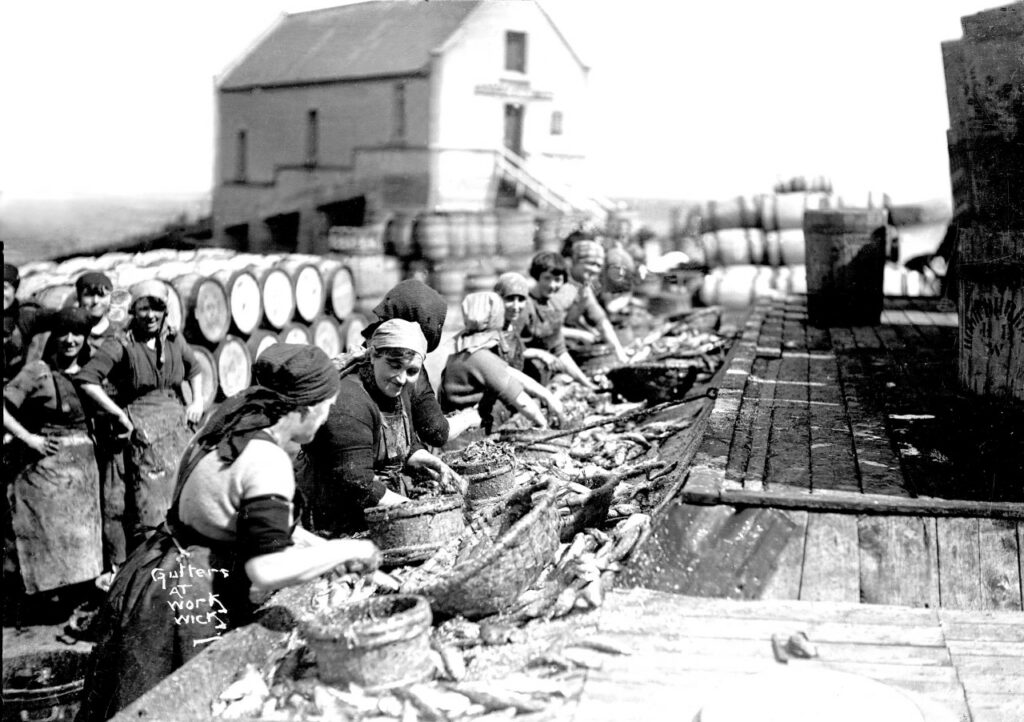
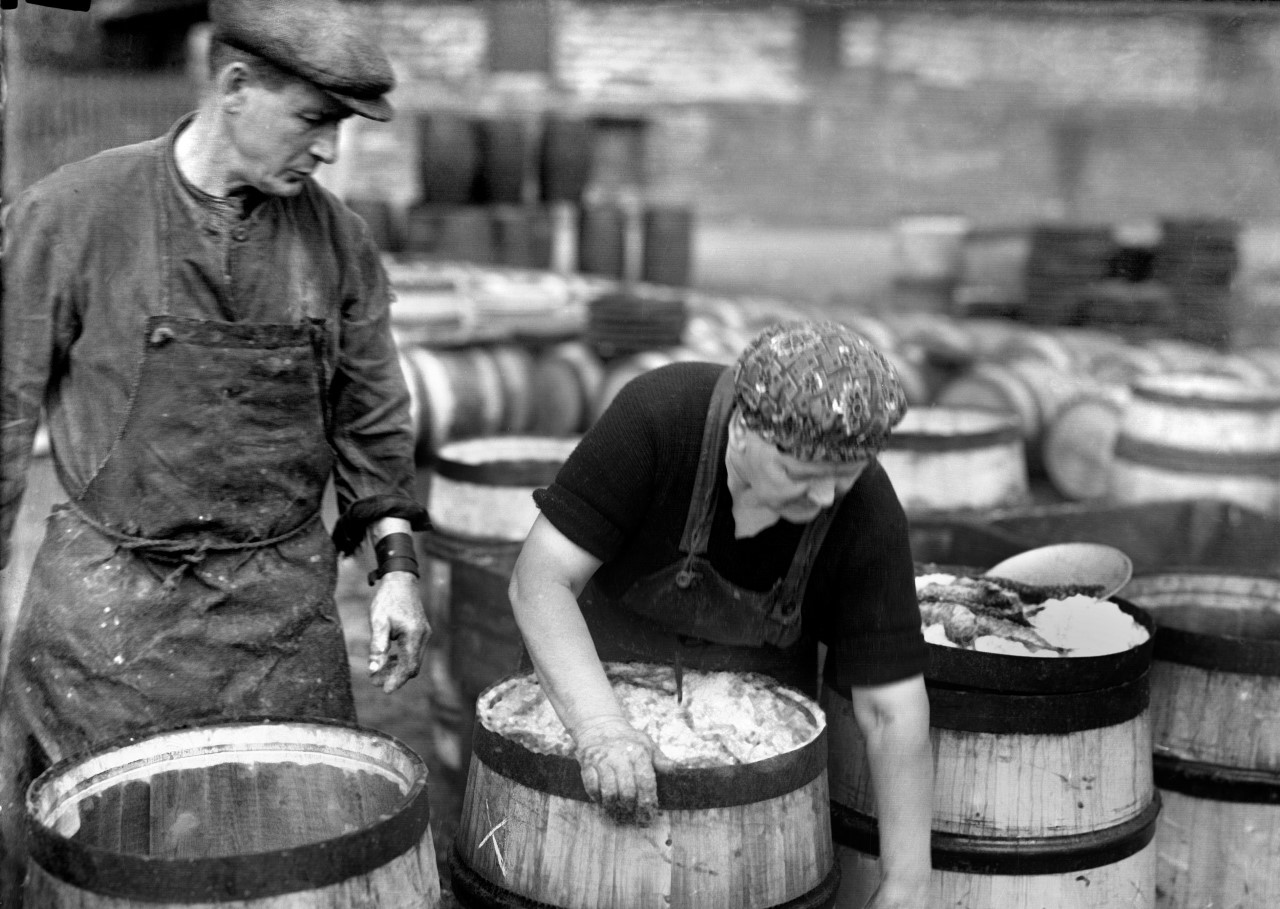
The last herring boom ended during the 1960s, following decades of unsustainable harvest coupled with natural variation in stock sizes [1]. Changing tastes for white fish, limited market access and innovations in technology impacted the herring industry further [10]. In the 1970s, herring stocks on both sides of the North Atlantic collapsed, when an abrupt drop in sea surface temperature occurred in the Northern Hemisphere [11]. Unfavourable environmental conditions, such as very high or unusually low temperatures at spawning grounds, or experienced during the egg/larval phase of development, reduce the survival of juvenile herring. Stocks would naturally have experienced lower levels of survival into older age classes (adulthood) during the period of cold temperatures. Nevertheless, high fishing pressure continued, and this likely contributed to the stock collapses that occurred in that decade [12, 13].
Geographic locations of herring spawning grounds and fishing areas in Scottish and adjacent seas. Roman numerals indicate ICES (the International Council for the Exploration of the Seas) subareas for the management of fish stocks in British waters and adjacent seas. Source: Frost & Diele (2022) Rev Fish Biol Fisheries.
Herring are managed as distinct stocks that occur within certain spatial areas, known as ICES Areas (see map above) [14, 15]. The International Council for the Exploration of the Seas (ICES) is a governmental advisory organisation, made up of scientists from member-countries (including Scotland), that compiles fisheries data and publishes advice on the number of herring (and other commercial fish) that could be sustainably fished yearly (since 1957) from each stock. In Scottish waters, two herring stocks are assessed by ICES: the North Sea Autumn Spawning stock, fished in the northeast, and the West of Scotland autumn spawning stock, fished to the west of the Hebrides. The Clyde herring stock is managed separately, since it is only present in UK waters. Thus it is the sole responsibility of the UK to assess and set fishing levels for the Clyde herring stock.
Fishing for herring in the North Sea and West of Scotland was banned by the Government in the late 1970s, to allow stocks to recover from collapse. Fishing in the North Sea resumed in 1983 after the stock recovered. Stricter management measures were implemented and continue to this day. The stock consists of three major populations, identifiable by differences in spawning time and location. These populations are Buchan/Shetland herring, which spawn in August and September; Banks and Dogger herring, which spawn from August to October; and Downs herring, which spawn from November to January [16].
The West of Scotland stock has remained in decline since the early 1980s [17, 18], and its composition has changed dramatically over the 20th century. Historically, it was a predominantly spring-spawning stock that came inshore to spawn along the west coast, though autumn-spawning herring were also present in small numbers [1]. It is now managed exclusively as an autumn-spawning stock, which spawns offshore to the west of the Hebrides [15]. In 2022, ICES provided a new assessment on the autumn-spawning herring, and advised that in 2023 a small catch could be permitted for the first time in several years [19]. Spring-spawning herring West of Scotland are not currently assessed by ICES. However, large shoals of herring were observed for the first time in nearly 50 years off Wester Ross – a region on the west coast that once prospered from herring fisheries – in the Spring of 2018 and 2019 [20, 21].
The Firth of Clyde supported a large spring-spawning herring population in the past. Habitat degradation, pollution and high herring mortality levels have had serious ecological impacts, and large herring shoals have not been seen there for a number of years [22, 23]. The UK Fisheries Administrations asked Marine Scotland to carry out a consultation on increasing the amount of herring caught in 2022. However, there was no supporting evidence for the increase, but further consultations continue.
A.

B.

A. Catches of North Sea Autumn Spawning herring from 1947 – 2021. B. Landings of West of Scotland Autumn Spawning herring from 1957 – 2021. Note: “Catch” is a measure of the fish removed from the marine environment at sea, whereas “landings” are the part of the catch that are brought to port. Source: ICES 2022 advice for herring in Division 6.a (North) and in Subarea 4 and divisions 3.a and 7.d.
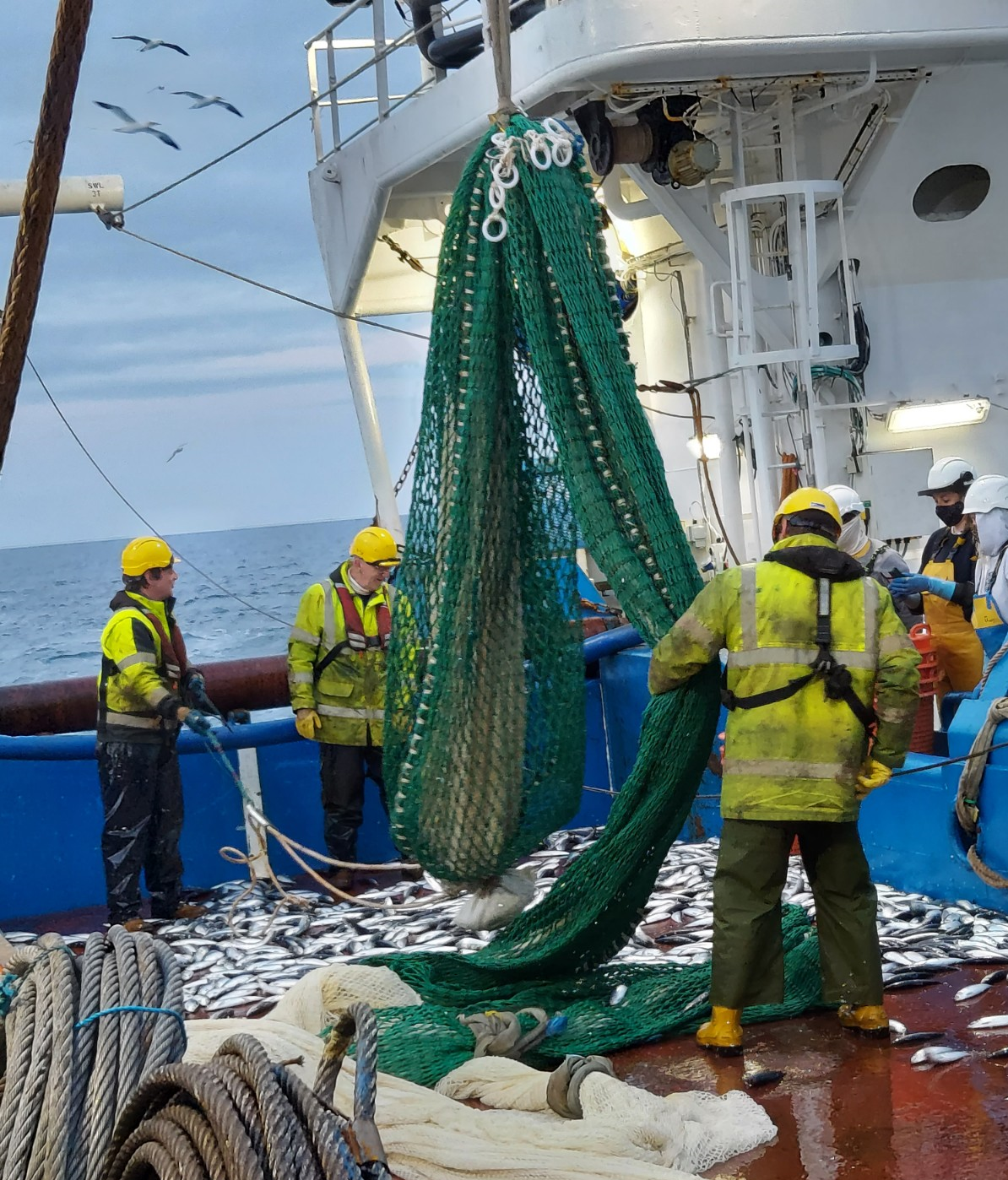
In Scottish waters, the amount of herring that can be fished [commercially] is allocated by quotas, which are a share of the catch. Every year, a “Total Allowable Catch” (TAC) for each herring stock is set (by weight) based on ICES recommendations to ensure sustainable levels of fishing. The Scottish Government Directorate Marine Scotland is responsible for managing and controlling quota limits within the Scottish Zone, including the North Sea and west of Scotland out to 200 nautical miles. The current system of quota allocation in Scotland is based on the “Fixed Quota Allocation” (FQA) system [24]. This was first implemented in 1999, when quota allocation units were distributed among commercial fishing licences based on catches recorded between 1994-1996 [25]. The system allowed for transfers of quota between licence holders, which led to large movement and accumulation of quotas in the years that followed, and continues to be allocated each year based on fishing track records from the previous years [26]. The Scottish Government now issues most allocations to Fish Producer Organisations (PO), which are cooperatives of fishing companies, that then manage their members’ quotas. Vessels that are not members of a PO, as well as the 10 metre and under fleet, are subject to catch limits set by the Government. However, they tend to fish for stocks where more quota is available, like Nephrops, or no quota is required, like scallops.
Early record of inshore seasonal local herring fishing
Main herring fisheries were in sheltered waters of the Firths of Forth and Clyde
Dutch dominate herring fishing
James V of Scotland encourages fishermen from Fife to fish herring in the Hebrides
Scottish fishermen adopt fishing and curing practices from Dutch fishermen
Government grant licenses and bounties for boat-building and curing herring, incentivising herring fishing
Introduction of Fishery Board to inspect cured herring and establish quality control “crown brand” stamp
Expanding market in Europe, W. Indies slavery plantations, and Ireland results in rapid fishery growth
Over a million barrels of cured herring are exported
Scotland Herring Fisheries employ over 35,000 people
“Herring Boom” where 2,500,000 barrels of fish were cured and exported to mainland Europe
Over 10,000 boats involved in the Scottish Herring Industry
First World War interrupts the growth of herring fishing as fishermen are sent to the Royal Naval Reserve
Declining industry is interrupted by World War 2
Herring fisheries expand to unsustainable levels
Introduction of Exclusive Economic Zones
North Sea herring quotas introduced
Highest catch rates in the Minch in decades due to displacement of fishing from the North Sea
Quotas are introduced in the Minch following poor recruitment and overfishing
Climax of North Atlantic cold water inflow (record cold temps)
North Sea herring ban
Minch herring ban
West of Scotland herring mainly spawn in autumn outside the Minch
North Sea herring fishery re-opened after strong recruitment
Common Fisheries Policy implemented
Removal of 3-mile limit
NE Atlantic begins warming to record temps
Legislation passed - stricter management measures in the North Sea
Herring recruitment decreases in the North Sea but bounces back again in subsequent years
Large shoals of spring inshore-spawning herring were spotted again on the Scottish West coast
A special thank you to The Wick Society for their contribution of photos from the Johnston Photographic Collection.
Banner image: Herring gutters in the yard c1900-1909. Wick Society, Johnston Photographic Collection.
[1] Coull JR (1986) The Scottish herring fishery 1800-1914: Development and intensification of a pattern of resource use. Scott Geogr Mag 102:4–17. https://doi.org/10.1080/00369228618736643
[2] Rorke M (2005) The Scottish herring trade, 1470-1600. Scott Hist Rev 84:149–165. https://doi.org/10.3366/shr.2005.84.2.149
[3] Harland J, Parks R (2008) Technical Report: The fish remains from the Holm of Papa Westray North, a Neolithic chambered tomb. Reports from the Centre for Human Palaeoecology. Report 2008/14. University of York. York
[4] Graham M (1956) Sea Fisheries. Their Investigation in the United Kingdom. Lond. 57-59.
[5] Scottish Fisheries Museum – The Herring Boom. https://www.scotfishmuseum.org/the-herring-boom.php. Accessed 25 Jan 2022
[6] Kumpulainen R (2001) Timber and Herring: Modernisation and Mobility in Finnish Lapland and The Western Islands of Scotland, 1770-1970
[7] Britton E (2012) Women as agents of wellbeing in Northern Ireland’s fishing households. Marit Stud 11:1–22. https://doi.org/10.1186/2212-9790-11-16
[8] Nadel-Klein J (2000) Granny baited the lines: Perpetual crisis and the changing role of women in Scottish fishing communities. Womens Stud Int Forum 23:363–372. https://doi.org/10.1016/S0277-5395(00)00094-7
[9] de Fresnes J (2010) Image and identity: The lives of the Scots herring Girls 1900-1950. Dissertation, The Open University
[10] Frost M, Diele K (2022) Essential spawning grounds of Scottish herring: current knowledge and future challenges. Rev Fish Biol Fish 32:721-744. https://doi.org/10.1007/s11160-022-09703-0
[11] Thompson DWJ, Wallace JM, Kennedy JJ, Jones PD (2010) An abrupt drop in Northern Hemisphere sea surface temperature around 1970. Nature 467:444-447. https://doi.org/10.1038/nature09394
[12] Corten A (1988) Shifts In Herring Spawning Areas In The Northwestern North Sea In Relation To Environmental Changes. ICES C.M. 1988/H:22. Ijmuiden
[13] Toresen R, Østvedt OJ (2008) Variation in abundance of Norwegian spring-spawning herring (Clupea harengus, Clupeidae) throughout the 20th century and the influence of climatic fluctuations. Fish Fish 1:231–256. https://doi.org/10.1111/j.1467-2979.2000.00022.x
[14] Kerr LA, Hintzen NT, Cadrin SX, et al (2017) Lessons learned from practical approaches to reconcile mismatches between biological population structure and stock units of marine fish. ICES J. Mar. Sci. 74:1708–1722
[15] Farrell ED, Campbell N, Carlsson J, et al (2020) Herring in Divisions Assessment of the Identity of the Southern and Northern Stocks through Genetic and Morphometric Analysis. Final Report.
[16] Barreto E, Bailey N (2015) Marine Scotland Science. Fish and shellfish stocks.
[17] ICES (2014) Celtic Seas Herring in Division VIa (North). ICES Advice June 2014
[18] ICES (2020a) Herring (Clupea harengus) in divisions 6.a and 7.b–c (West of Scotland, West of Ireland). ICES Advice on fishing opportunities, catch, and effort Celtic Seas ecoregion
[19] ICES (2022) Herring (Clupea harengus) in Division 6.a (North), autumn spawners (West of Scotland). ICES Advice on fishing opportunities, catch, and effortCeltic Seas ecoregion. Available here.
[20] Cunningham (2018) Spring spawning herring rediscovered to the west of Gairloch. Available here.
[21] Cunningham (2019) Wester Ross spring spawning herring recorded on video to the west of Red Point, near Gairloch. Available here.
[22] ICES (2019) Herring Assessment Working Group for the area south of 62° N (HAWG). ICES Scientific Reports. Copenhagen.
[23] Mcintyre F, Fernandes PG, Turrell WR (2012) Clyde Ecosystem Review. Scottish Mar Freshw Sci 3:59–60
[24] Marine Scotland Science (2020) Advice and guidance. Sea fisheries: allocating and managing Scotland’s quota. Available here.
[25] Scottish Government (2019) Future Fisheries Management. National Discussion Paper on Future of Fisheries Management in Scotland – 2019. Analysis Report. Available here.
[26] Marine Scotland Science (2014). Consultation on the Allocation of Scottish Fish Quotas. Consultation paper. Available here.
Email: [email protected]